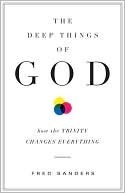More on this book
Community
Kindle Notes & Highlights
by
Fred Sanders
Read between
November 6, 2016 - July 12, 2017
Never yet has any man been heard to testify that he had been the wretched and hopeless slave of sin, and had continued in spiritual darkness, fast bound in misery and vice until his eyes were opened by the great truth that two and two make four, or that three angles of a triangle are equal to two right angles; and that thereby his life had been transformed, his soul delivered from bondage, and his heart filled with joy and peace in believing.18
Christian prayer is already thoroughly, pervasively, structurally Trinitarian whether you have been noticing it or not.
Christian prayer, as a subset of Christian communion with God, is an approach to God the Father, through God the Son, in the Holy Spirit.
The whole Trinity has to do with our return and reception. The Father throws open His presence chamber, the Holy of Holies where He dwells; the Son provides the way for our restoration, by answering in His death all the ends that could have been served by our exclusion; and the Holy Spirit conducts us into the Father’s presence along the new and living way.1
This may help us somewhat to understand how the prayer of man, coming through the Son, can have effect upon God.The decrees of God are not decisions made by Him without reference to the Son, or His petition, or the petition to be sent up through Him. By no means.The Lord Jesus is the first-begotten,the Head and Heir of all things: all things were created through Him and unto Him, and all things consist in Him. In the counsels of the Father, the Son, as Representative of all creation, had always a voice; in the decrees of the eternal purpose there was always room left for the liberty of the Son
...more
Who do I pray to? The Father? The Son? The Spirit? God? The Trinity? All of the above?
Here is the theologically correct answer: pray to the Father, in the name of the Son, through the power of the Holy Spirit.
This is a famous passage, and Lewis argues his way through it very tidily.19 He uses the language of the three dimensions, exploring the relationship between the higher, more complex dimensions and the lower, simpler ones. Lines are one-dimensional things, but when they are taken into the second dimension, they can be combined to form a square. Squares are two-dimensional, but if they are transposed into the third dimension, six of them can coexist as one cube. As you progress to dimensions that are “more real and more complex,” you do not leave behind the lower dimensions; you combine them in
...more


